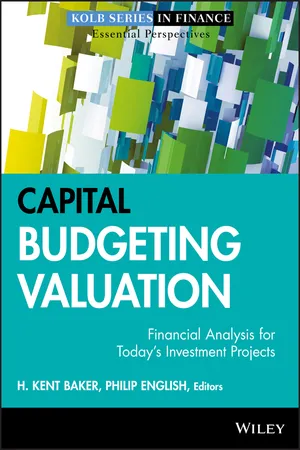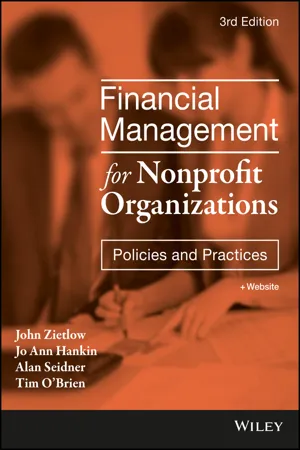Business
Capital Budget
A capital budget refers to the allocation of funds for long-term investment in assets such as property, equipment, or infrastructure. It involves evaluating potential projects, estimating their costs and benefits, and making decisions about which investments to pursue. Capital budgeting helps businesses plan for and manage their long-term financial commitments and growth opportunities.
Written by Perlego with AI-assistance
Related key terms
Related key terms
1 of 4
Related key terms
1 of 3
11 Key excerpts on "Capital Budget"
- eBook - ePub
Capital Budgeting Valuation
Financial Analysis for Today's Investment Projects
- H. Kent Baker, Philip English(Authors)
- 2011(Publication Date)
- Wiley(Publisher)
Chapter 1 Capital Budgeting: An Overview H. KENT BAKER University Professor of Finance and Kogod Research Professor, Kogod School of Business, American University PHILIP ENGLISH Assistant Professor of Finance, Kogod School of Business, American University INTRODUCTION Capital Budgeting refers to the process that managers use to make decisions about whether long-term investments or capital expenditures are worth pursuing by their organizations. In other words, Capital Budgeting is the process of planning, analyzing, selecting, and managing capital investments. The basic notion is that managers use the capital, usually long-term funds, raised by their firms to invest in assets (also called capital goods) that will enable the firm to generate cash flows for at least several years into the future. Typical investments include replacements of existing assets and expansion of existing or new product lines. Capital Budgeting is one of the most challenging tasks facing management because it concerns the investment decision, which deals with allocating funds over time in order to achieve a firm's objectives. For most companies, the investment decision has a greater impact on value than does the financing decision, which deals with acquiring needed funds. However, both investment and financing decisions are intertwined and at the heart of financial management. Capital Budgeting has a long-term focus that provides a link to an organization's strategic plan, which specifies how an organization expects to accomplish long-term strategic goals. Many capital investments require a substantial commitment of a firm's resources that directly affect firm performance, competitive position, and future direction. Because capital investments often commit a large amount of funds for lengthy periods, they are not only difficult or costly to reverse but also difficult to convert to more liquid assets (Migliore and McCracken, 2001) - eBook - ePub
- Sandeep Goel(Author)
- 2015(Publication Date)
- Business Expert Press(Publisher)
SECTION 2 Capital Budgeting Decision & AppraisalPassage contains an image CHAPTER 2 Capital Budgeting: Nature & Scope
IntroductionThe Present ChapterIt discusses the concept of Capital Budgeting, its process, techniques, and risk analysis of capital investment decisions by the business units.Capital Budgeting decision relates to decision of investment in long-term projects. Capital Budgeting is often used interchangeably with capital expenditure or capital investment. Any expenditure that generates a cash flow benefit for more than one year, it is a capital expenditure. For example, the purchase of new equipment, expansion of production capacity, buying another company, research & development, and so on. Capital Budgeting involves large cash outlays for generating future return of the company. Once, a Capital Budgeting decision is committed, it is often difficult to reverse. Therefore, we need to carefully analyze and evaluate proposed Capital Budgeting decisions.“Capital Budgeting is long-term planning for making and financing proposed capital outlays.” —Charles T. Horngnen “Capital Budgeting is concerned with the firm’s formal process for the acquisition and investment of capital.” —Hamption, John. J.In a capital investment decision, the major criterion for selection of a project is its viability and impact on shareholder value. The two most important parameters for arriving at a project decision are the project’s expected cash inflows and outflows. They determine whether the returns meet a sufficient target benchmark or not.Capital Budgeting Decision: An OverviewThe Capital Budgeting decision, as already pointed out, pertains to investment in fixed assets/long-term assets and the returns are expected over a long period of time. It is the process of identifying, analyzing, and selecting investment projects whose returns (cash flows) are expected to extend beyond one year.1 - eBook - ePub
- Robert Irons(Author)
- 2019(Publication Date)
- Routledge(Publisher)
7 Capital Budgeting Decision MethodsCapital, in a business sense, refers to money, while a budget is basically a plan. So Capital Budgeting decision methods are the tools firms use to plan how they are going to invest money to grow their business. Each year firms construct a new budget for the following year—it is a long, involved process that rarely goes smoothly. The firm’s managers look for new ways for the firm to expand, whether it is new products and services, new production methods, new distribution venues or the like. They champion specific projects based on their analysis of the project’s potential impact on the firm’s profitability, and their annual bonuses are tied to the performance of their pet projects. Thus, the annual Capital Budget is the largest recurring project most firms experience. Skill in budgeting is a good way to climb the corporate ladder.The secret to growing a business is simple: invest in projects that earn more than they cost. If a project covers its own costs and the costs the firm pays its investors, any money left over can be used to invest in more projects and thereby fuel more growth. This chapter discusses the major methods used by firms to value potential investment projects, and a solid understanding of these methods is necessary to becoming a good financial analyst. We will discuss five major methods used for valuing investment projects: the payback period (PB) and discounted payback period (DPB), the net present value (NPV), the internal rate of return (IRR) and the modified internal rate of return (MIRR). Each of these methods will be shown using an Excel spreadsheet for the calculations. We will also review the method for determining the net operating cash flows for the projects based on the incremental cash flows associated with the project. Finally, we will review the method for determining the firm’s optimal Capital Budget. - eBook - ePub
Financial Strategies and Topics in Finance
Selected Public Lectures of Professor Harold Bierman, Jr. from 1960–2015
- Harold Bierman Jr(Author)
- 2017(Publication Date)
- WSPC(Publisher)
Lecture 28
Management of Risk and Capital Budgeting
This is one of only a few talks that were fully written out. The talk was given in 1992 at the Johnson School.After the management of a firm has completed its planning process, the resulting long range strategic plan has to be translated into a specific plan of action which actually allocates resources. I will call the specific plan to allocate resources the Capital Budget and Capital Budgeting is the process of arriving at the plan.It is convenient to divide investments into two general classifications. First we classify all investment opportunities that are economically independent of each other. Thus an automobile manufacturer might consider replacing its automobile production line with a more labor efficient set of machines, or it might consider entering the airline industry. These are two independent investment alternatives. They compete for financial resources, but their cash flows are economically independent.Once we have determined the independent investments we must next consider all investments which perform the same economic function, where only one investment will be accepted. These are “mutually exclusive” investments.The objective of the Capital Budgeting process is to make accept or reject decisions involving independent investments (we can undertake all independent investments that are desirable) and “best of the set” decisions involving mutually exclusive investments (we can undertake only one of the mutually exclusive investments). In making these investment decisions there is implied some known and agreed upon objective for the firm.As a first step we should clearly indicate the corporate objectives that are not affecting the Capital Budgeting process. We are not attempting to maximize total sales or percentage share of market. Growth is not the goal (though growth might occur if the correct decisions are made) nor are earnings per share and total earnings being maximized. The goal is to maximize the risk adjusted net present value of the stockholders’ position and we assume that in doing so we are maximizing the well-being of the stockholders. The decisions are being made from the point of view of the stockholders and it is assumed that their interests are best served by a procedure that systematically assigns a cost to the capital that is utilized in the production process. - eBook - ePub
- John Hampton(Author)
- 2011(Publication Date)
- AMACOM(Publisher)
Feasible . The goals of the project should be realistic. That is, the objectives must be realizable within the capabilities and resources that can be allotted to the project.• Focused . The Capital Budget itself should provide guidance for decision making. It starts with the outlay that begins the project and concludes at the end of a planning horizon with a forecasted financial value.• Directional . The numbers should show a pathway to follow from the launch of the project to maturity of financial outcomes.• Flexible . Discussions of cash flows and returns should include adjustments that might be needed if assumptions do not work out or conditions change.All this is well and good and is part of Capital Budgeting, but first the company must have the financial tools to develop cash flow streams that can be understood by management. Then, the cash flows must be adjusted for the time value of money so that the risk in the timing of cash flows and likely returns is clearly understood by decision makers. In this chapter, we cover the framework of Capital Budgeting and the careful creation of cash flow streams. In the next chapter, we cover the calculation of returns.FOUNDATION OF Capital BudgetING
The preparation of a Capital Budget and decisions to invest in real estate or purchase other capital assets represent a long-term commitment by any private company. In this section, we will examine the concepts that assist in making such commitments.Significance of Capital Budgeting
The commitment of funds to fixed asset investments is significant to the firm for a number of reasons:• Substantial dollar amounts . These investments are generally made in large projects involving tens or even hundreds of millions of dollars. In terms of dollars alone, Capital Budgeting decisions are significant to even the largest corporations.• Long time periods - Jerome B. McKinney(Author)
- 2015(Publication Date)
- Praeger(Publisher)
There is a total lack of an effective national capital improvement plan. In fact, the federal government maintains no Capital Budgeting system or procedure. As a result, most federally owned facilities “are deteriorating and the Government is faced with the prospect of either repairing or rehabilitating them, or risking a staggering replacement burden in the future.” 3 Additionally, if the existing deteriorating situation is not addressed, sooner than later, the economic competitiveness of the United States could be significantly degraded. The chapter examines the Capital Budgeting processes, financing approaches, and techniques for ranking and selecting capital projects. Throughout, stress is placed on both successful and unsuccessful practices. Defining Capital Budgeting A number of terms are used interchangeably to refer to Capital Budgeting, such as public works planning, capital improvements planning, capital facilities planning, and capital outlay planning. The use of so many terms creates an increased opportunity for misunderstanding the definition of Capital Budget. Most often, the term refers to the legislative plan for proposed capital outlays and the means of financing them for the coming fiscal period. The Capital Budget is often a part of the regular budget. When a capital facilities or capital program improvement is in operation, the Capital Budget will be the first-year component. Capital Budget’s Critical and Indispensable Role The importance of Capital Budgets in local government cannot be overstressed. Capital expenditure is a major component of most local budgets and plays a significant role in the delivery of public services and the economic welfare of local communities. It is in the Capital Budget that many of the most critical policy issues are articulated. Capital Budgeting is typically responsible for bringing together many different departmental personnel and technical specialties or disciplines- eBook - ePub
Canadian Public-Sector Financial Management
Second Edition
- Andrew Graham(Author)
- 2014(Publication Date)
- McGill-Queen's University Press(Publisher)
Simply treating capital expenditures as current expenditures taken out of operating budgets distorts the true costs of the asset acquisition. Having capital projects dependent on year-to-year approvals restricts the capacity of the organization to commit to the full cost of the project. Approving an investment in the first phase of major construction, and then reviewing it entirely without approving the next phase, can lead to a series of complications ranging from waste of public funds to a reluctance to engage in the high-risk venture in the first place. Finally, it is often the case that capital projects involve long-term debt for the organization. The challenge of long-term financing involves a good understanding of the true costs of the investment, a process of analysis quite different from analyzing operating expenditures.A distinction that has already been drawn between operating and Capital Budgets is that of time. Operating budgets are generally appropriated and reported upon for a single fiscal year, although many governments are providing information on future years and some actually provide multi-year approvals. The Capital Budget, while it involves actual cash disbursements within the course of a fiscal year, more often involves a flow of cash over a number of years to create an asset with a life longer than one year. Both the investment flow and the asset return extend over a considerable period of time.In addition, as governments move more aggressively into accrual accounting and budgeting, they will be forced to treat capital differently. As an example, adequate budgeting for, and reporting of, capital depreciation will highlight capital costs as never before. So, too, will the reporting of the current costs of debt to finance capital. In the case of voluntary organizations, capital acquisitions are often linked to the organization’s debt planning and credit ratings and thus receive particular attention. Figure 7.5 : Budget of the City of Lethbridge provides a good example of a budget presentation that combines a summary of operating and capital expenditures. Behind that summary document, it has to be remembered, is a 400-page budget statement and a separate Capital Improvement Plan.1 - eBook - ePub
- Gerald J. Miller(Author)
- 2017(Publication Date)
- Routledge(Publisher)
Unlike the operational budget that may change overnight or from one fiscal year to the next, Capital Budgets convey a more permanent sense of priorities and direction. Although the funding of Capital Budgets is done through annual appropriations, many times its approval amounts to the passing of a multiyear budget. According to Axelrod (1988:277), governments use multiyear budgeting to change the direction of budget priorities, to help stabilize the priorities of programs and projects, to control expenditures, to discourage piecemeal decisions, and to lighten the budgetary workload. In addition to its possible contributions as a form of a multiyear budget, Capital Budgets can help program managers develop a better understanding of the opportunities and the constrains on future action. With the addition of a new office building or the introduction of a new information technology system to the CIP, a practicing manager could tell that the odds of seeing an affirmative action on a request to build another building or to purchase another system shortly after are low. From a strategic management point of view the important thing is that all managers at all levels and across the board are likely to get a similar message about the future of any such requests. At the same time it may encourage individual managers to search independently of each other for ways to exploit the new opportunities that result from such an improvement. Any success in this regard amounts to an improvement on the rate of return on the involved investment. Knowing that by the end of a given period the organization is going to have a new capacity in any respect may encourage managers to look for opportunities to take advantage of it, possibly by initiating new or different programs or work processes. Here, too, the logic of the garbage can model of decision making illustrates how possible solutions can start floating around in search of problems. These initiatives by managers may prevent inertia from settling in. This, in turn, can diminish the risk of overlooking an emerging threat, a likely event when inertia does settle in.Strategic management is designed to cut across departmental lines and functional areas in pursuit of the strategic plan. The development of a Capital Budget follows the same approach with results that are very different from the ones usually obtained from the regular budgeting process. It is only a slight exaggeration to suggest that it is only during the annual budget cycle that the individual departments of a local government, for example, are forced to acknowledge that they are indeed part of the same agency. The needs of central staff units such as finance, personnel, electronic data processing, and purchasing are not likely to be factored into the workplans of the individual operating departments. Managers develop workplans for their respective units without worrying about the budgetary implications for other line and staff units. Resolving such problems is assumed to be the domain of the budget department or the top manager. It is not uncommon for staff and line units to organize their individual operations on the basis of a narrow, provincial view of the public’s needs; this serves as an enormous centrifugal force in the local government organization. - eBook - ePub
- William J. Ward Jr.(Author)
- 2015(Publication Date)
- Praeger(Publisher)
Chapter 7 The Capital Budget Capital Budgeting, which includes equipment and facility renovations, customarily takes place as part of the annual budgeting process. It involves integration of the short-term and long-term operating needs of the organization with regard to equipment acquisition and renovations. By considering the goals and objectives in the annual plan and the three-to-five year business plan, resources are not consumed in acquiring equipment that is not consistent with these objectives. By definition, equipment dealt with in this budget has an acquisition cost in excess of a stated dollar amount (perhaps $1,000—as determined by each organization) and has a life of more than one year. The cost of this equipment is not charged to an expense account. It is carried on the balance sheet and depreciated over the course of its life. Capital Acquisition The acquisition of capital equipment and renovation projects should occur via one of three possible methods: as part of the annual plan, as part of a multi-year or strategic capital plan, or as a response to a developing business opportunity. Part of the annual plan. This is the normal approach to capital equipment budgeting for new items, replacement equipment for older, worn-out pieces or pieces that have become technologically obsolescent, and renovations to the physical plant. Renovations can result from a need to refresh cosmetically or modernize space, improve functionality, or provide for a new or expanded function. Acquisitions and renovations made as part of the annual plan must be consistent with the organization’s strategic plan. If the strategic plan envisions the replacement of monitoring systems throughout the critical care units in 20X3 and 20X4 with Brand A equipment, the short-term goal must support that. In 20X2, it would not be prudent to acquire monitors that are incompatible with Brand A - eBook - ePub
- Alan J. Baker(Author)
- 2018(Publication Date)
- Routledge(Publisher)
9 Aspects of Capital Budgeting There is such a choice of difficulties thatI am myself at a loss how to determine. James Wolfe9.1 Introduction
Capital Budgeting has become an enormously wide-ranging discipline, and within a single chapter its variety of subject areas, techniques and theoretical connections can hardly be given full coverage. But our progression in this chapter is intended to give some idea of how the subject extends from somewhat mechanical but nonetheless useful variations on the basic theme of the NPV/MVWACC criterion (e.g. the lifetime/retirement calculations of Section 2 ) through areas of dispute on the application of basic theory (e.g. the capital rationing debate in Section 3 ) to the fringes of modern ‘managerial’ theories of the firm (the various models of risk taking in Sections 4 and 5 ).Two topics in particular receive less attention here than is customary in expositions of Capital Budgeting theory and practice. The theoretical debate between the net present value (NPV) and internal rate of return (IRR) concepts of investment profitability is one which may already be familiar to readers, and it seems appropriate to deal with the main issues raised in this debate in an Appendix to this chapter. Readers who are uncertain of these issues should read the Appendix before proceeding with the material in the chapter. (The NPV versus IRR debate also figures in our discussion of capital rationing in 9.3.) Our broad preference throughout the chapter for the NPV approach to profitability measurement stems both from doubts about the IRR concept expressed in the Appendix , and from the obvious appropriateness of a measure of investment profitability defined in broadly the same terms as management is assumed to adopt in framing the firm’s overall financial objective, namely the market’s valuation of shareholders’ wealth.The second omission from this chapter is the application of decision tree analysis to sequential investment decision making. However, this topic is generally well covered in standard texts and in articles (e.g. Levy and Sarnat, 1978, pp. 196-202; Magee, 1964 and 1964a; and Hespos and Strassman, 1965), and the relevant principles have been explained in Chapter 7 - eBook - ePub
Financial Management for Nonprofit Organizations
Policies and Practices
- John Zietlow, Jo Ann Hankin, Alan Seidner, Tim O'Brien(Authors)
- 2018(Publication Date)
- Wiley(Publisher)
CHAPTER 9 LONG-RANGE FINANCIAL PLANNING AND Capital BudgetING- 9.1 INTRODUCTION
- 9.2 PLANNING FOR THE FUTURE
- (a) Importance of Long-Range Financial Planning
- (b) CFO’s Role in Financial Planning and Capital Budgeting
- (c) Deferred Maintenance: A Cautionary Tale
- (d) Long-Range Financial Planning Process
- (e) Financial Planning Basics
- (f) Develop a Financial Model
- (g) Project and Reevaluate Target Liquidity
- (h) Based on Our Financial Policies and Structure, How Fast Can We Grow?
- 9.3 FINANCIAL EVALUATION OF NEW AND EXISTING PROGRAMS
- (a) Simple Portfolio Analysis
- (b) Advanced Portfolio Analysis
- (c) Annual Necessary Investment
- 9.4 Capital BudgetING: FINANCIAL EVALUATION OF PROJECTS THAT ARISE FROM EXISTING PROGRAMS
- (a) Example 1: Net Present Value and Benefit-Cost Ratio Illustrated
- (b) Example 2: Equivalent Annual Cost Illustrated
- (c) How to Manage the Total Capital Budget
- (d) Capital Budget and Capital Rationing
- (e) Rationing the Capital
- 9.5 FINANCIAL EVALUATION OF MERGERS, JOINT VENTURES, AND STRATEGIC ALLIANCES
- (a) Mergers and Acquisitions
- (b) Motives for Mergers and Acquisitions
- (c) Partnerships, Joint Ventures, and Strategic Alliances
- (d) Strategic Alliances
- 9.6 FINANCIAL PLANNING AND Capital BudgetING IN PRACTICE
- 9.7 CONCLUSION
- APPENDIX 9A: CASE STUDY: KIAWAH ISLAND COMMUNITY ASSOCIATION
- APPENDIX 9B: EVALUATING SOCIAL ENTERPRISES
9.1 INTRODUCTION
If we consider that nonprofit boards carry a primary responsibility for the fiscal life of the organizations that they govern, then it follows that long-range financial planning is a primary method for carrying out that responsibility.1 Very often, the fiscal responsibility role is viewed within the frame of the annual budget but we postulate that nonprofit organizations need to reframe this to incorporate long-range planning.2
Index pages curate the most relevant extracts from our library of academic textbooks. They’ve been created using an in-house natural language model (NLM), each adding context and meaning to key research topics.
Explore more topic indexes
Explore more topic indexes
1 of 6
Explore more topic indexes
1 of 4










